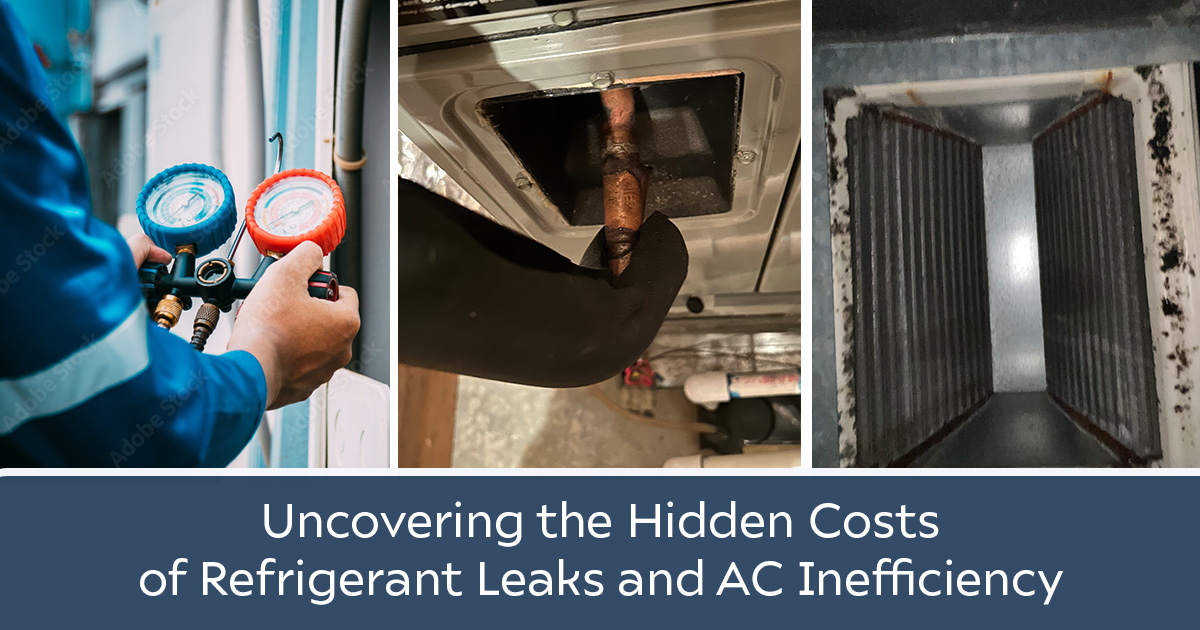One often-overlooked issue that can lead to costly repairs is a low refrigerant level in the HVAC system of a home. Refrigerant, commonly referred to as Freon – R-22 (a brand name for older refrigerants) plays a critical role in keeping your home cool. If it’s low, you may be in for more than just a warm house—you could face thousands of dollars in repairs
Why Do Refrigerant Levels Matter
Refrigerant is essential for your air conditioning system to function properly. It absorbs heat from inside the home and releases it outside, allowing your home to stay cool. Unlike fuel in a car, refrigerant doesn’t get “used up” over time; it should remain at a consistent level unless there’s a leak or a system malfunction.
If the refrigerant is low, it’s a red flag that there’s likely a leak in the system. While a simple recharge (refill) of refrigerant may seem like an easy fix, it’s only a temporary solution. The real problem is the leak itself, which can lead to serious HVAC issues.
How Low Refrigerant Can Cost You Big Money
1. Higher Energy Bills
When an HVAC system is running low on refrigerant, it has to work much harder to cool your home. This leads to longer run times, increased strain on the system, and higher electricity costs. Over time, this inefficiency can cost you hundreds or even thousands of dollars in wasted energy.
2. Costly Repairs or Replacement
If a home you’re considering purchasing has an air conditioner with low refrigerant, it could be a sign of:
- A minor leak that needs to be repaired (typically $200–$1,500)
- A major leak requiring significant repairs (potentially $2,000+)
- A failing compressor due to strain, which can cost upwards of $5,000 to replace
- A completely failing HVAC system, which may require a full replacement costing $8,000–$12,000
3. Expensive Refrigerant Costs
Many older AC units use R-22 Freon, which has been phased out due to environmental concerns. Since production of R-22 stopped in 2020, the cost of recharging an older system can be prohibitively expensive, often exceeding $1,000 for a single refill. If you buy a home with an outdated system, you may be forced to upgrade to a newer unit that uses either R-410A or R-454B, which means an even bigger expense.
4. Health and Safety Risks
Refrigerant leaks don’t just affect your wallet—they can also impact indoor air quality. Prolonged exposure to refrigerant leaks can cause health issues such as dizziness, headaches, nausea, and respiratory problems. If a home has low refrigerant due to an ongoing leak, it’s crucial to have it repaired before moving in.
As a new home buyer, during the home inspection, make sure to ask for a full HVAC evaluation rather than just a basic check. A professional HVAC technician can assess refrigerant levels, check for leaks, and determine the system’s overall condition.
Low refrigerant levels might seem like a minor issue, but they can indicate serious HVAC problems that could cost a homebuyer thousands of dollars. Before closing on a home, make sure the air conditioning system is in good shape, or you could end up paying for costly repairs or even a full replacement soon after moving in. A little due diligence now can save you from major headaches—and expenses—down the road. Call and schedule Greer’s Heating & Air to inspect that HVAC before you sign on that dotted line.
CASE REPORT:
The downstairs of this home has an International Comfort Products gas pack from 2001. This system uses Freon (R-22) refrigerant. Gas packs are self-contained, pre-packaged HVAC systems that provide cooling and gas heating (via natural gas or LP gas) in one unit. Gas Packs of this type tend to have an average life expectancy of 14-20 years. Gas Packs that are well-maintained tend to last a little longer and those not maintained tend to last less time.
The upstairs has an International Comfort Products air conditioner from 2001. This system uses Freon (R-22) refrigerant. Air conditioners of this type tend to have an average life expectancy of 14-17 years. Air conditioners that are well maintained tend to last a little longer and those not maintained tend to last less time.
These systems use Freon (R-22) refrigerant. FYI: This refrigerant was phased out of production in January of 2020 but will still be available (current plan) through 2030 as a recycled refrigerant. Units that still use this refrigerant are not going to be “banned” or even discouraged from being used, except that recycled refrigerant will become more and more scarce as time goes by, and repair costs will increase accordingly.
An alternative would be to use a substitute (often called a “drop-in”) refrigerant. We are constantly evaluating the many drop-ins currently available. We do NOT recommend any drop-ins currently – even if they are approved by the manufacturers.
At this time, should it become necessary to move away from Freon (R-22) refrigerant. Our current recommendation is an upgrade to “Puron” (R-410a). This is a pretty big decision, though. It would mean that the entire downstairs system/AC side upstairs would have to be replaced and that usually ranges from $10,000 to $12,000(downstairs), $6,000 to $8,000 (upstairs) depending on the model and other installation factors. This is not normally something folks do unless there’s some other major factor dictating it (like a bad compressor, cracked heat exchanger, etc.).






